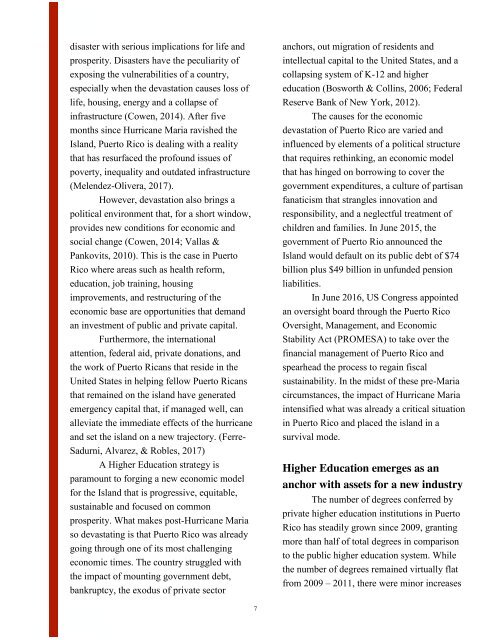CLC-Conference-Proceeding-2018
Create successful ePaper yourself
Turn your PDF publications into a flip-book with our unique Google optimized e-Paper software.
disaster with serious implications for life and<br />
prosperity. Disasters have the peculiarity of<br />
exposing the vulnerabilities of a country,<br />
especially when the devastation causes loss of<br />
life, housing, energy and a collapse of<br />
infrastructure (Cowen, 2014). After five<br />
months since Hurricane Maria ravished the<br />
Island, Puerto Rico is dealing with a reality<br />
that has resurfaced the profound issues of<br />
poverty, inequality and outdated infrastructure<br />
(Melendez-Olivera, 2017).<br />
However, devastation also brings a<br />
political environment that, for a short window,<br />
provides new conditions for economic and<br />
social change (Cowen, 2014; Vallas &<br />
Pankovits, 2010). This is the case in Puerto<br />
Rico where areas such as health reform,<br />
education, job training, housing<br />
improvements, and restructuring of the<br />
economic base are opportunities that demand<br />
an investment of public and private capital.<br />
Furthermore, the international<br />
attention, federal aid, private donations, and<br />
the work of Puerto Ricans that reside in the<br />
United States in helping fellow Puerto Ricans<br />
that remained on the island have generated<br />
emergency capital that, if managed well, can<br />
alleviate the immediate effects of the hurricane<br />
and set the island on a new trajectory. (Ferre-<br />
Sadurni, Alvarez, & Robles, 2017)<br />
A Higher Education strategy is<br />
paramount to forging a new economic model<br />
for the Island that is progressive, equitable,<br />
sustainable and focused on common<br />
prosperity. What makes post-Hurricane Maria<br />
so devastating is that Puerto Rico was already<br />
going through one of its most challenging<br />
economic times. The country struggled with<br />
the impact of mounting government debt,<br />
bankruptcy, the exodus of private sector<br />
anchors, out migration of residents and<br />
intellectual capital to the United States, and a<br />
collapsing system of K-12 and higher<br />
education (Bosworth & Collins, 2006; Federal<br />
Reserve Bank of New York, 2012).<br />
The causes for the economic<br />
devastation of Puerto Rico are varied and<br />
influenced by elements of a political structure<br />
that requires rethinking, an economic model<br />
that has hinged on borrowing to cover the<br />
government expenditures, a culture of partisan<br />
fanaticism that strangles innovation and<br />
responsibility, and a neglectful treatment of<br />
children and families. In June 2015, the<br />
government of Puerto Rio announced the<br />
Island would default on its public debt of $74<br />
billion plus $49 billion in unfunded pension<br />
liabilities.<br />
In June 2016, US Congress appointed<br />
an oversight board through the Puerto Rico<br />
Oversight, Management, and Economic<br />
Stability Act (PROMESA) to take over the<br />
financial management of Puerto Rico and<br />
spearhead the process to regain fiscal<br />
sustainability. In the midst of these pre-Maria<br />
circumstances, the impact of Hurricane Maria<br />
intensified what was already a critical situation<br />
in Puerto Rico and placed the island in a<br />
survival mode.<br />
Higher Education emerges as an<br />
anchor with assets for a new industry<br />
The number of degrees conferred by<br />
private higher education institutions in Puerto<br />
Rico has steadily grown since 2009, granting<br />
more than half of total degrees in comparison<br />
to the public higher education system. While<br />
the number of degrees remained virtually flat<br />
from 2009 – 2011, there were minor increases



